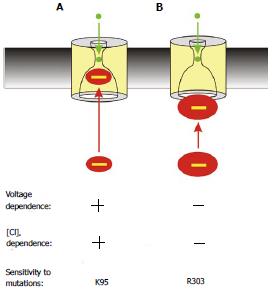Copyright
©2014 Baishideng Publishing Group Co.
World J Biol Chem. Feb 26, 2014; 5(1): 26-39
Published online Feb 26, 2014. doi: 10.4331/wjbc.v5.i1.26
Published online Feb 26, 2014. doi: 10.4331/wjbc.v5.i1.26
Figure 5 Two distinct proposed mechanisms of block by cytoplasmic anions.
A: The effects of most blockers are voltage- and Cl- dependent (as described in Figure 2) and are sensitive to mutations that remove the positive charge at K95; B: The large multivalent anion suramin blocks the channel in a voltage- and Cl- independent fashion, and its effects are dependent on a positive charge at R303 but independent of K95. This is interpreted as the large suramin molecule blocking the cytoplasmic entrance to the pore; at a site that does not involve entering significantly into the transmembrane electric field or approaching close enough to Cl- ions inside the pore to experience repulsive electrostatic interactions.
- Citation: Linsdell P. Cystic fibrosis transmembrane conductance regulator chloride channel blockers: Pharmacological, biophysical and physiological relevance. World J Biol Chem 2014; 5(1): 26-39
- URL: https://www.wjgnet.com/1949-8454/full/v5/i1/26.htm
- DOI: https://dx.doi.org/10.4331/wjbc.v5.i1.26









